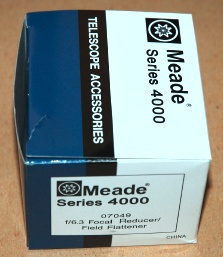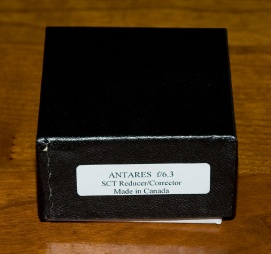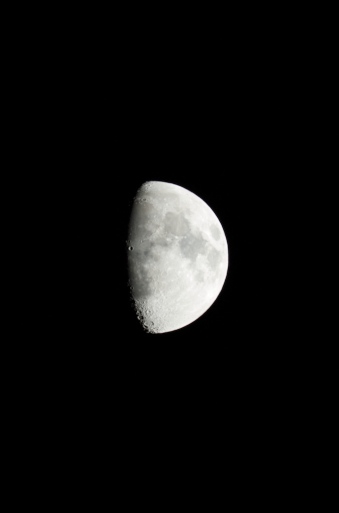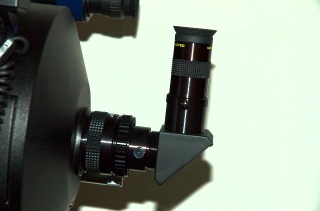
Meade and Antares Focal Reducers Review
Last updated: 11 October 2008
OPT provided the two SCT Focal Reducers for this comparison. I had planned to use the focal reducers with my LXD75-8"SC but the day I picked up the Meade focal reducer was the same day I discovered that the telescope and almost all my accessories had been stolen. My testing has been delayed until just recently when I received a new 8" LX90-ACF. This report is an initial comparison of the following focal reducers using the same visual and photographic tests on a Meade 8" LX90-ACF.
The Meade focal reducer comes in a small box. Inside the box is a "bottle" style case and a two-sided instruction sheet. Inside the case is the focal reducer with caps on both ends.




The Antares focal reducer comes in small box. It has only one cover, which surprised me. You attach the focal reducer to the rear port on a SCT and can keep it covered. But when not in the box or on the telescope, there is no cover for the other end. I wish there was.



With a 2000mm focal length f/10 telescope like a 8" SC or 8" ACF, both the Antares reducer and the Meade reducer yield a 1260mm focal length f/6.3 telescope. This makes the telescope a "faster" system with a wider field of view and brighter objects, requiring shorter exposure times when doing astrophotography.
During my 8 October 2008 visit to Oracle Observatory, I did the testing with an 8" LX90-ACF telescope. My first tests were using the moon. It was one day past First Quarter and so made a good target to show the reduction in image size. All of the moon photographs below are full-frame taken with my Nikon D70 DSLR at prime focus with the adapters described. This first moon image is to establish the baseline, non-reduced image scale. It was taken with the camera attached to the Meade standard 1.25" star diagonal.

I then attached the Meade focal reducer to the telescope, with the 1.25" diagonal attached to the reducer:

With the telescope Alt/Az mounted and the OTA pointed at the zenith, there is about 1cm of clearance to the mount base. In the 26mm eyepiece I could just see a hint of the central obstruction. Without the star diagonal, the view was better in the 26mm eyepiece and in the camera. Of note is that I could not reach a focus in the camera with the camera attached to the star diagonal. Here's the moon through the Meade reducer without the star diagonal:

The increase in the field of view and the reduction of the magnification is evident if you compare the two moon photos.
I then switched to the Antares focal reducer, with the 1.25" star diagonal:

There was still about 1cm of clearance from the base when pointed at the zenith. With the star diagonal and 26mm eyepiece the central obstruction was not visible. Here's the moon through the Antares reducer with the star diagonal:

Here's the moon through the Antares reducer without the star diagonal:

Notice that there is a difference between the two reducers when not using the star diagonal. This means there is a slight difference in the amount of focal reduction with the reducers.
I then used the Antares reducer with the OPT 2" star diagonal:

With this larger diagonal the maximum elevation is about 75° when mounted in Alt/Az. The central obstruction was not visible in the 26mm eyepiece. Here's the moon through the Antares reducer with the 2" star diagonal:

I then combined the Meade focal reducer with the 2" diagonal:

Again, the maximum elevation was about 75°. But that didn't matter as I could not reach a focus with the 1.25" 26mm eyepiece, a 2" 30mm eyepiece, nor with the camera with this combination of Meade focal reducer and 2" diagonal.
I changed back to the Antares reducer with the 2" star diagonal. I could focus again and noticed that with the 2" 30mm eyepiece some chromatic aberration was evident at the moon's limb. With a 2" 50mm eyepiece, the central obstruction was just barely visible.
I then attached an Off-Axis Guider to the Antares focal reducer:

Now the maximum elevation was about 60° and could be less, depending on the camera body attached. The camera would focus but I had to slide the guide eyepiece out a little bit in the eyepiece holder to get the eyepiece to focus. There was no restriction in the guide eyepiece field of view. Here's the moon through the Antares reducer with the Off-Axis Guider:

I swapped to the Meade focal reducer and attached the Off-Axis Guider:

Again the maximum elevation was about 60° and could be less, depending on the camera body attached. The camera would focus but the field of view in the guide eyepiece was very restricted. I had the same eyepiece focus problem but again, sliding it slightly outward allowed it to focus. However, the usable image was only at the very edge of the eyepiece field of view. It would be extremely difficult to find and track a guide star in the restricted field of view. Here's the moon through the Meade reducer with the Off-Axis Guider:

After I completed these intial tests I did some more visual tests using the Double Cluster open star cluster. Here are the results of those tests:
Baseline: no focal reducer, 1.25" star diagonal, 1.25" 26mm eyepiece. Both clusters were just visible in the field of view.
Meade focal reducer, 1.25" star diagonal, 1.25" 26mm eyepiece. Both clusters were well visible in the center of the FOV. Some distortion of the stars was evident at the edge of the field of view.
Antares focal reducer, 1.25" star diagonal, 1.25" 26mm eyepiece. Both clusters were well visible in the center of the FOV although there was slightly more magnification. No distortion of the stars was seen at the edge of the field of view.
Antares focal reducer, 2" star diagonal, 2" 30mm eyepiece. Both clusters were near the center of the FOV. Some distortion of the stars was evident at the edge of the field of view.
Meade focal reducer, 2" star diagonal, 2" 30mm eyepiece. Could not achieve a focus.
Based on these initial photographic and visual tests I prefer the Antares focal reducer over the Meade focal reducer. The Antares focused in all my test scenarios whereas the Meade had some problems reaching focus with some accessories. The physical and optical quality seemed to be essentially identical for both but the Antares model is somewhat less costly.
I will update this page after I use the focal reducers on my new 8" LX200-ACF and test under dark skies, including some astrophotography tests.
Go to the LX90-ACF Table of Contents.
Go to Mike & Laurraine's Home Page.